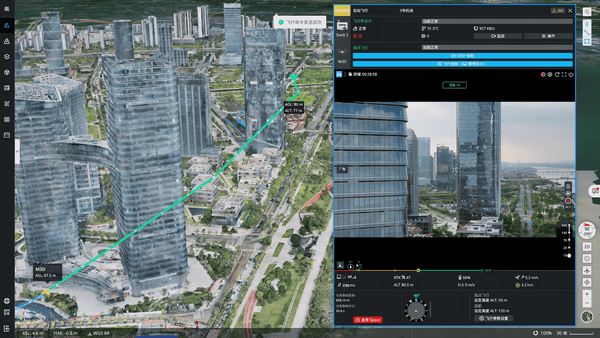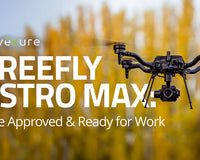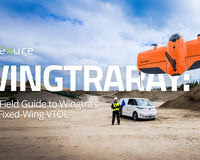In the ever-evolving world of UAS technology, DJI has once again pushed the envelope with the release of DJI Dock 2. With its official launch in China on Nov 8th, 2023, and eventual release in other markets, Dock 2 is set to revolutionize the way industries like surveying, inspections, and public safety approach their remote unmanned operations. Here’s the latest information.
A Lighter, More Portable, and Faster Dock
The first thing to note is that Dock 2 has seen a significant weight reduction of 68% and a size reduction of 75% when compared to Dock 1. Weighing in at just 34kg (75 lbs.), Dock 2 can be easily transported by a two-person team.
Like its predecessor, Dock 2 carries an IP55 rating, can withstand harsh inclement weather, and is dustproof and waterproof. In the event your flight mission encounters bad weather, Dock 2 can quickly abort the mission, reducing potential flight risks. Dual RTK antennas on the Dock ensure that a deployed aircraft can get an even more accurate positioning for a return landing without relying on its own RTK.
Deployment time has significantly improved, with setup time reduced from an average of 5 hours to 30 minutes. The integrated dual RTK modules and internal and external fisheye cameras provide real-time environmental feedback, with blade detection, safety checks, and takeoff possible in just 45 seconds, assuming you’re in an environment with a good network signal. Actual deployment times may vary on location.
Charging times have also seen an improvement, with the ability to charge Dock 2 from 20% to 90% in approximately 32 minutes, reducing downtime and making continuous operation possible. In the event of a power outage, the built-in battery supports over 5 hours of independent charge, allowing for a safe RTH in emergency situations.
DJI Dock 2 and Matrice 3D/3TD Technical Specifications
| Total weight, excluding drone | 75 lbs. |
| Dimensions | Hatch cover open: length 50", width 23", height 16.2" Hatch cover closed: length 22.4", width 23", height 18.3" mm |
| Input voltage | 100V to 240V (AC), 50/60 Hz |
| Input power | Maximum 1000 watts |
| Charging output | 28 volts DC |
| Charging time | 20% to 90% in 32 minutes |
| Working temperature | -25°C to 45°C |
| IP rating | IP55 |
| Drones in use at a single time | 1 |
| Max wind speed for landing | 8m/s |
| Max operating altitude | 8,202 ft. |
| RTK base station frequency | GPS: L1 C/A, L2BeiDou2: B1l, B2l, B3lBeiDou3: B1l, B3lGLONASS: L1, L2Galileo: E1, E5B |
| RTK base station accuracy | Horizontal: 1 cm + 1 ppm (RMS) Vertical: 2 cm + 1 ppm (RMS) |
| Image transmission | O3 Enterprise Edition |
| Image transmission frequency | 2.4000 GHz to 2.4835 GHz 5.725 GHz to 5.850 GHz |
| Antenna | Four antennas, two transmitters, and four receivers, support intelligent switching |
| Air conditioning | TEC air conditioner at 28 volts DC |
| Backup battery | 12Ah, 12-volt lead-acid battery |
| Backup battery life | 5 hours |
| Network connectivity | 1GB ethernet, 4G |
| Sensors | Wind speedRainAmbient temperatureWater immersionCabin temperatureCabin humidity |
| Security camera | 2x 1080p 151° camera with spotlight. One external and one internal |
| Lightning protection | AC power: 20 kA protection (rated value), meeting Type 2 of EN 61643-11 and Class II protection level of IEC 61643-1Ethernet: 10 kA protection (total current value), meeting the Category C protection level of EN/IEC 61643-21 |
| Compatible software | DJI Pilot 2 (with RC Pro Enterprise) DJI FlightHub 2DJI Cloud API |
| Drone Weight | 3.1 lbs. |
| Maximum take-off weight | 3.54 lbs. |
| Drone Dimensions | 13.2" long,15.6" wide, 6" height (excluding propellers) |
| Max ascent speed | 13.4 mph (normal mode) 17.8 mph (sport mode) |
| Max descent speed | 13.4 mph (normal mode) 13.4 mph (sport mode) |
| Max flight speed | Normal mode, obstacle avoidance turned on: forward flight 33.5 mph, backward flight 26.8 mph side flight 22.3 mph. Sports mode: forward flight 47 mph, backward flight 40.2 mph, side flight 35.7 mph. |
| Max wind resistance | Wind resistance during operation: 26.8 mph Wind resistance during takeoff and landing: 17.9 mph. |
| Max take-off altitude | 1.55 mi. |
| Max flight time | 50 minutes |
| Max operational range | 6.21 mi. |
DJI Matrice 3D Series: Built for Remote Operations
Dock 2 also comes standard with the all-new Matrice 3D series of drones. Unlike the Matrice 30T, the 3D lineup has a smaller form factor and is specially designed for Dock 2 and remote operations. You can think of them as IP-rated versions of the M3E and M3T.  With public safety and inspection use cases in mind, the M3TD comes equipped with wide-angle, telephoto zoom, and thermal cameras and can simultaneously capture RGB and thermal video.
With public safety and inspection use cases in mind, the M3TD comes equipped with wide-angle, telephoto zoom, and thermal cameras and can simultaneously capture RGB and thermal video. M3D is equipped with a telephoto zoom camera and a wide camera with a mechanical shutter, which can produce 1,500 maps for surveying and mapping. Both drones feature an IP54 protection level, up to 50 minutes of flight time, and a 400-cycle battery life, reducing the cost per flight by 50%.
M3D is equipped with a telephoto zoom camera and a wide camera with a mechanical shutter, which can produce 1,500 maps for surveying and mapping. Both drones feature an IP54 protection level, up to 50 minutes of flight time, and a 400-cycle battery life, reducing the cost per flight by 50%.
Matrice 3D & 3DT Camera Sensor Features
| DJI Matrice 3D | DJI Matrice 3TD | |
| Wide-angle Camera |
|
|
| Telephoto Camera |
|
|
| Thermal Camera |
|
|
Largely the Same Flighthub 2 with Some Improvements
Flighthub 2 is the brain behind the operation, offering cloud-based intelligent operations and true remote operations. It allows for remote control, quick route planning, and multi-dimensional information collection.
The high-precision 3D models generated by Flighthub 2 enable operators to edit routes visually and simulate shooting results, enhancing operational efficiency and safety.

Flighthub 2 Software Features
| Feature | Details |
| Cloud Modeling | Upon the completion of a route mission by the aircraft, FlightHub 2 is capable of creating a detailed 3D model utilizing the flight path's data, thus reconstructing the flight's operational environment. This model allows for enhancements such as annotations, measurements, and the capability to export for various uses. |
| Route Editor | Leveraging the detailed 3D models, route editing is transformed into a more immersive process, allowing operators to adjust flight paths from the perspective of the pilot and assess potential data collection outcomes through simulation. This enhances the ease and efficiency of operations and bolsters the precision in planning flight routes. |
| Accurate Reshooting in the Cloud | enables the drone to autonomously align its camera to retarget and reshoot a predefined area in the 3D model accurately, guaranteeing that repeated flights capture the exact same location with precise camera angles in automated follow-up missions. |
| Point & Fly | Utilizing the detailed 3D models, FlightHub 2’s pointing flight functionality empowers it to automatically determine and set the most efficient and safe trajectory to a location designated by the operator with a simple selection, streamlining response times for urgent missions. |
| Remote Control | Operators can maintain full command over the drone's navigational and camera orientations from afar using keyboard and mouse inputs through FlightHub 2 or an alternative cloud service, ensuring operability even when the Dock is situated in isolated locales. |
| Route Detour | In the course of performing automated route missions, the drone is engineered not just for recognizing obstacles in all directions but also for intelligently circumnavigating them, thereby augmenting the likelihood of uninterrupted mission accomplishment. |
Cloud API for 3rd Party Data Management
A Cloud API extends the capabilities of Dock 2 by allowing integration with third-party cloud platforms for privatized deployment. This feature broadens the operational scope, enabling users to achieve closed-loop business flows and innovate within their industries.











